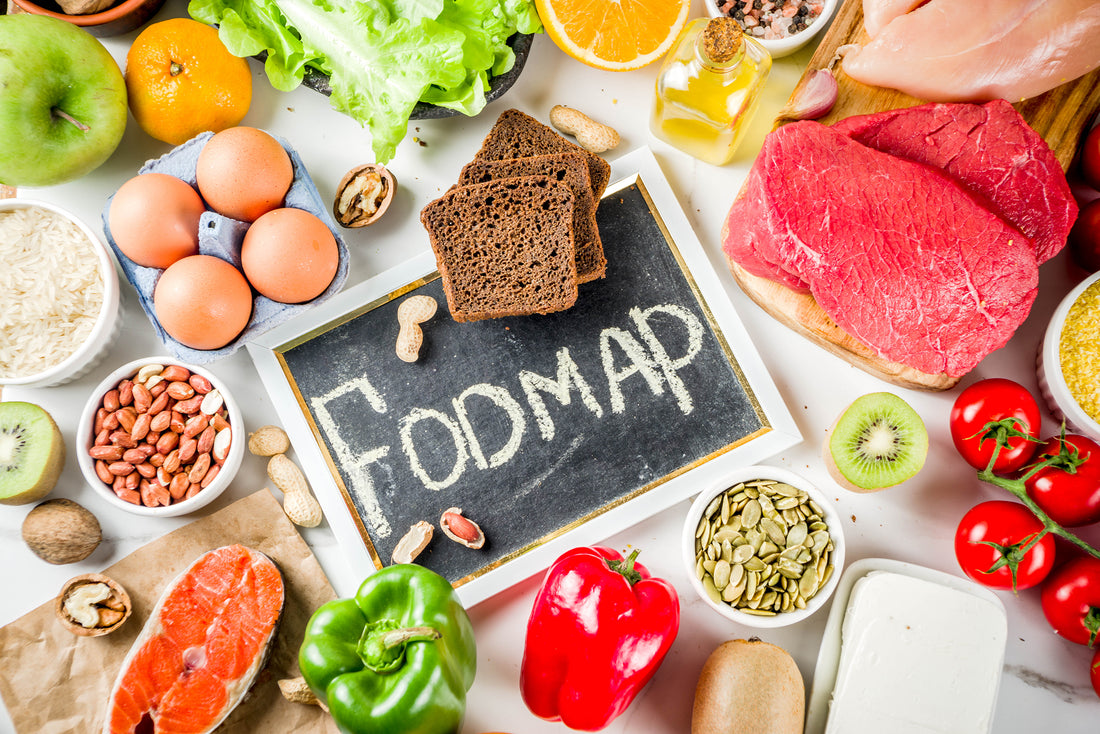WRITTEN BY R.D.N ANTONIO GÓMEZ
What is a FODMAP DIET?
The low FODMAP diet stands for:
Fermentable - Oligosaccharides (oligo –“few,” saccharide – “sugar”)
Disaccharides (“two sugars”)
Monosaccharides (“one sugar”)
And Polyols (another type of sugar are with a molecule of alcohol)
In other words, is a fancy and complex name just to refer to a diet low in fermentable and simple carbohydrates or sugars.

Carbohydrates = Sugars
From a nutritional-biochemical point of view, sugars are called carbohydrates and they have a huge misnomer, nutritionally speaking people tend to relate them to “food that makes you fat” and even in nutritional literature the labeling and sorting of these type of molecule are misleading.
The key point to understand is that carbohydrates encompass a huge array of molecules, from simple (low number of molecules) to complex (a greater number of molecules) and even from fermentable (soluble fiber or prebiotics) to non-fermentable (insoluble fiber), so as you can see, depending on the topic you can classify carbohydrates in many categories.
If you want a more detailed explanation of the types of classifications of carbohydrates (sugars) check our previous post “Sugar, friend or foe”.
Understanding FODMAP
Now that we have an idea of the different types of carbohydrates we need to understand its main role in the body, and that is “ENERGY”, and depending on the number of molecules of carbohydrates (or sugars) the more energy, the low FODMAP diet refers only to simple carbohydrates, in other words, the low number of carbohydrates molecules like Oligosaccharides, Disaccharides, and Monosaccharides that ranges from 1 to 10 molecules of sugars, low energy foods.
Polyols are a type of sugar that can be found naturally in some fruits and vegetables but also be produced synthetically, they are also called sugar alcohols and used widely in the food industry as thickeners and sweeteners for commercial products, xylitol and sorbitol are popular sugar alcohols in commercial foods found in artificial sweeteners/sugar substitutes like Splenda.
Now that we have understood the basics we can now say that the objective of the low FODMAP diet is to LIMIT and/or AVOID food containing specific carbohydrates, being 4:
- Oligosaccharides
- Disaccharides
- Monosaccharides
- Polyols
Foods to limit or avoid in a low FODMAP diet
Foods that do not contain carbohydrates are not a concern like protein and fats, like meat, poultry, fish, eggs, butter, oils, and other types of food very high in protein and or fat with very little to none carbohydrates.
The next list provides a guide of the food you need to limit and/or avoid because they are HIGH in FODMAP.
-
Foods high in Oligosaccharides (up to 10 molecules of sugars) cereals and legumes like wheat, barley, rye, soy (any presentation), and beans.

-
Food high in Disaccharides and Monosaccharides (1 to 2 molecules of sugar) dairy, vegetables, and fruits like any lactose based milk, yogurt and cheese, beets, broccoli, cabbage, apple, pears, and watermelon.

-
Food high in Polyols (sugar alcohols) mainly in candies like popsicles and artificial sweeteners.

Purpose of the low FODMAP diet (Expert Opinion)
The low FODMAP diet is a regime often prescribed in clinical nutrition in hospitals to patients after a digestive tract surgery and/or for diagnosed patients with digestive disorders like Irritable Bowel Syndrome (IBS) or functional abdominal pain, the aim for the diet is to decrease symptoms such as excessive gas, bloating, abdominal pain, nausea, vomiting, diarrhea and/or constipation by limiting or avoiding fermentation in a non-healthy digestive tract.
By no means is a diet that should be implemented by everyone, like any other diet, there’s no such thing as a “better” or “superior” style of diet, the best diet is the one that works best for each person, everyone is different so a diet should always be prescribed by a registered Nutritionist, based on blood work, physical examination and an extensive medical query the best nutritional strategy is tailored.
“All diets can work as a point of reference, if you are experiencing symptoms like constipation, excessive gas, bloating or any gut discomfort consult with a Nutritionist this type of diet, our Quinoa Cereals line up are an allowed cereal in a low FODMAP diet with zero artificial sweeteners and high in protein making it a great option to optimize your health.”


For more information about IBS visit:
http://www.ibsgroup.org
For more research on the diet visit:
https://www.monash.edu/medicine/ccs/gastroenterology







24 comments
https://emc-mee.com/blog.html شركات نقل العفش
اهم شركات كشف تسربات المياه بالدمام كذلك معرض اهم شركة مكافحة حشرات بالدمام والخبر والجبيل والخبر والاحساء والقطيف كذكل شركة تنظيف خزانات بجدة وتنظيف بجدة ومكافحة الحشرات بالخبر وكشف تسربات المياه بالجبيل والقطيف والخبر والدمام
https://emc-mee.com/cleaning-company-yanbu.html شركة تنظيف بينبع
https://emc-mee.com/blog.html شركة نقل عفش
اهم شركات مكافحة حشرات بالخبر كذلك معرض اهم شركة مكافحة حشرات بالدمام والخبر والجبيل والخبر والاحساء والقطيف كذلك شركة رش حشرات بالدمام ومكافحة الحشرات بالخبر
https://emc-mee.com/anti-insects-company-dammam.html شركة مكافحة حشرات بالدمام
شركة تنظيف خزانات بجدة الجوهرة من افضل شركات تنظيف الخزانات بجدة حيث ان تنظيف خزانات بجدة يحتاج الى مهارة فى كيفية غسيل وتنظيف الخزانات الكبيرة والصغيرة بجدة على ايدى متخصصين فى تنظيف الخزانات بجدة
https://emc-mee.com/tanks-cleaning-company-jeddah.html شركة تنظيف خزانات بجدة
https://emc-mee.com/water-leaks-detection-isolate-company-dammam.html شركة كشف تسربات المياه بالدمام
https://emc-mee.com/ شركة الفا لنقل عفش واثاث
https://emc-mee.com/transfer-furniture-jeddah.html شركة نقل عفش بجدة
https://emc-mee.com/transfer-furniture-almadina-almonawara.html شركة نقل عفش بالمدينة المنورة
https://emc-mee.com/movers-in-riyadh-company.html شركة نقل اثاث بالرياض
https://emc-mee.com/transfer-furniture-dammam.html شركة نقل عفش بالدمام
https://emc-mee.com/transfer-furniture-taif.html شركة نقل عفش بالطائف
https://emc-mee.com/transfer-furniture-mecca.html شركة نقل عفش بمكة
https://emc-mee.com/transfer-furniture-yanbu.html شركة نقل عفش بينبع
https://emc-mee.com/transfer-furniture-alkharj.html شركة نقل عفش بالخرج
https://emc-mee.com/transfer-furniture-buraydah.html شركة نقل عفش ببريدة
https://emc-mee.com/transfer-furniture-khamis-mushait.html شركة نقل عفش بخميس مشيط
https://emc-mee.com/transfer-furniture-qassim.html شركة نقل عفش بالقصيم
https://emc-mee.com/transfer-furniture-tabuk.html شركة نقل عفش بتبوك
https://emc-mee.com/transfer-furniture-abha.html شركة نقل عفش بابها
https://emc-mee.com/transfer-furniture-najran.html شركة نقل عفش بنجران
https://emc-mee.com/transfer-furniture-hail.html شركة نقل عفش بحائل
https://emc-mee.com/transfer-furniture-dhahran.html شركة نقل عفش بالظهران
https://emc-mee.com/transfer-furniture-kuwait.html شركة نقل عفش بالكويت
https://emc-mee.com/price-transfer-furniture-in-khamis-mushit.html اسعار شركات نقل عفش بخميس مشيط
https://emc-mee.com/numbers-company-transfer-furniture-in-khamis-mushit.html ارقام شركات نقل عفش بخميس مشيط
https://emc-mee.com/new-company-transfer-furniture-in-khamis-mushit.html شركة نقل عفش بخميس مشيط جديدة
https://emc-mee.com/transfer-furniture-from-khamis-to-riyadh.html شركة نقل عفش من خميس مشيط الي الرياض
https://emc-mee.com/transfer-furniture-from-khamis-mushait-to-mecca.html شركة نقل عفش من خميس مشيط الي مكة
https://emc-mee.com/transfer-furniture-from-khamis-mushait-to-jeddah.html شركة نقل عفش من خميس مشيط الي جدة
https://emc-mee.com/transfer-furniture-from-khamis-mushait-to-medina.html شركة نقل عفش من خميس مشيط الي المدينة المنورة
https://emc-mee.com/best-10-company-transfer-furniture-khamis-mushait.html افضل 10 شركات نقل عفش بخميس مشيط
https://emc-mee.com/%D8%B4%D8%B1%D9%83%D9%87-%D9%86%D9%82%D9%84-%D8%B9%D9%81%D8%B4-%D8%A8%D8%AC%D8%AF%D9%87.html
https://emc-mee.com/%D8%B4%D8%B1%D9%83%D8%A9-%D9%86%D9%82%D9%84-%D8%A7%D8%AB%D8%A7%D8%AB-%D8%A8%D8%AC%D8%AF%D9%87.html
شركة المتحدة
شركة نقل عفش بالخبر
شركة نقل عفش بالمدينة المنورة
شركة نقل عفش بالرياض
شركة نقل عفش بجدة
شركة نقل عفش بمكة
شركة نقل عفش بالطائف
شركة نقل عفش بينبع
شركة نقل عفش بنجران
شركة نقل عفش بخميس مشيط
شركة نقل عفش بجازان
شركة نقل عفش بابها
شركة نقل عفش ببريدة
شركة نقل عفش بالقصيم
شركة نقل عفش بتبوك
https://eslamiatview.blogspot.com/2023/02/cleaning-yanbu.html
https://trumpbookusa.com/blogs/608103/%D8%B4%D8%B1%D9%83%D8%A9-%D9%86%D9%82%D9%84-%D8%A7%D9%84%D8%A7%D8%AB%D8%A7%D8%AB-%D8%AF%D8%A7%D8%AE%D9%84-%D9%85%D9%83%D8%A9
https://www.exoltech.us/blogs/33488/%D8%B4%D8%B1%D9%83%D8%A9-%D9%86%D9%82%D9%84-%D8%A7%D9%84%D8%B9%D9%81%D8%B4-%D9%81%D9%89-%D9%85%D9%83%D9%87
https://www.tadalive.com/blog/18002/%D8%A7%D9%81%D8%B6%D9%84-%D8%B4%D8%B1%D9%83%D8%A9-%D9%86%D9%82%D9%84-%D8%A7%D8%AB%D8%A7%D8%AB-%D8%A8%D9%85%D9%83%D8%A9/
https://www.rolonet.com/blogs/207339/%D8%B4%D8%B1%D9%83%D8%A9-%D9%86%D9%82%D9%84-%D8%A7%D9%84%D8%A7%D8%AB%D8%A7%D8%AB-%D8%A8%D9%85%D9%83%D9%87
https://community.tccwpg.com/read-blog/184683
https://www.snipesocial.co.uk/blogs/195899/%D8%B4%D8%B1%D9%83%D8%A9-%D9%86%D9%82%D9%84-%D8%B9%D9%81%D8%B4-%D8%A8%D9%85%D9%83%D8%A9
https://degentevakana.com/blogs/view/151232
https://www.exoltech.us/blogs/35515/%D8%AE%D8%AF%D9%85%D8%A7%D8%AA-%D9%86%D9%82%D9%84-%D8%A7%D9%84%D8%B9%D9%81%D8%B4-%D9%88-%D8%A7%D9%84%D8%A7%D8%AB%D8%A7%D8%AB-%D9%81%D9%89-%D9%85%D9%83%D9%87
https://www.tadalive.com/blog/7271/%D8%A7%D9%81%D8%B6%D9%84-%D8%B4%D8%B1%D9%83%D8%A9-%D9%84%D9%86%D9%82%D9%84-%D8%B9%D9%81%D8%B4-%D8%A8%D8%AC%D8%AF%D8%A9-emc-mee-com-transfer-furniture-jeddah-html/
https://www.rolonet.com/blogs/115623/%D8%A7%D9%81%D8%B6%D9%84-%D8%B4%D8%B1%D9%83%D8%A9-%D9%84%D9%86%D9%82%D9%84-%D8%B9%D9%81%D8%B4-%D8%A8%D8%AC%D8%AF%D8%A9-emc-mee-com-transfer-furniture
https://community.tccwpg.com/read-blog/89293
https://www.latinosdelmundo.com/blog/-emc-mee-com-transfer-furniture-jeddah-html
https://degentevakana.com/blogs/view/102307
https://zlidein.com/read-blog/113179
https://justnock.com/read-blog/3896
https://www.snipesocial.co.uk/blogs/125331/%D8%B4%D8%B1%D9%83%D8%A9-%D9%86%D9%82%D9%84-%D8%A7%D9%84%D8%B9%D9%81%D8%B4-%D8%A8%D8%AC%D8%AF%D8%A9-emc-mee-com-transfer-furniture-jeddah
https://addandclick.com/read-blog/93660
https://www.tadalive.com/blog/7825/%D8%B4%D8%B1%D9%83%D8%A9-%D9%86%D9%82%D9%84-%D8%B9%D9%81%D8%B4-%D9%85%D9%86-%D8%AC%D8%AF%D8%A9-%D8%A7%D9%84%D9%89-%D8%AA%D8%A8%D9%88%D9%83/
https://www.rolonet.com/blogs/120270/%D8%B4%D8%B1%D9%83%D8%A9-%D9%86%D9%82%D9%84-%D8%B9%D9%81%D8%B4-%D9%85%D9%86-%D8%AC%D8%AF%D8%A9-%D8%A7%D9%84%D9%89-%D8%AA%D8%A8%D9%88%D9%83
https://community.tccwpg.com/read-blog/96917
https://degentevakana.com/blogs/view/104800
https://zlidein.com/read-blog/115007
https://www.snipesocial.co.uk/blogs/128309/%D8%A7%D9%81%D8%B6%D9%84-%D8%B4%D8%B1%D9%83%D8%A9-%D9%86%D9%82%D9%84-%D8%B9%D9%81%D8%B4-%D9%85%D9%86-%D8%AC%D8%AF%D8%A9-%D8%A7%D9%84%D9%89-%D8%AA%D8%A8%D9%88%D9%83
https://addandclick.com/read-blog/95783
https://justnock.com/read-blog/4876
https://www.tadalive.com/blog/8182/%D8%B4%D8%B1%D9%83%D8%A7%D8%AA-%D9%86%D9%82%D9%84-%D8%B9%D9%81%D8%B4-%D8%A8%D8%A7%D9%84%D8%B1%D9%8A%D8%A7%D8%B6-%D9%88%D8%AC%D8%AF%D8%A9-%D9%88%D9%85%D9%83%D8%A9-%D8%B4%D8%B1%D9%83%D8%A7%D8%AA-%D9%86%D9%82%D9%84-%D8%A7%D8%AB%D8%A7%D8%AB-%D8%A8%D8%A7%D9%84%D9%85%D8%AF%D9%8A%D9%86%D8%A9-%D8%A7%D9%84%D9%85%D9%86%D9%88%D8%B1%D8%A9/
https://www.rolonet.com/blogs/123414/%D8%A7%D9%81%D8%B6%D9%84-%D8%B4%D8%B1%D9%83%D8%A9-%D8%AA%D9%86%D8%B8%D9%8A%D9%81-%D8%A8%D9%8A%D9%86%D8%A8%D8%B9
https://degentevakana.com/blogs/view/106044
https://community.tccwpg.com/read-blog/104970
https://www.rolonet.com/blogs/124843/%D8%A7%D9%81%D8%B6%D9%84-%D8%B4%D8%B1%D9%83%D8%A9-%D9%84%D9%86%D9%82%D9%84-%D8%A7%D9%84%D8%B9%D9%81%D8%B4-%D8%AF%D8%A7%D8%AE%D9%84-%D9%85%D9%83%D9%87
https://www.tadalive.com/blog/8340/%D8%A7%D9%81%D8%B6%D9%84-%D8%B4%D8%B1%D9%83%D8%A9-%D9%86%D9%82%D9%84-%D8%A7%D8%AB%D8%A7%D8%AB-%D8%A8%D9%85%D9%83%D8%A9/
https://community.tccwpg.com/read-blog/105267
https://degentevakana.com/blogs/view/109457
https://zlidein.com/read-blog/117368
https://www.snipesocial.co.uk/blogs/131115/%D8%A7%D9%81%D8%B6%D9%84-%D8%B4%D8%B1%D9%83%D8%A9-%D9%84%D9%86%D9%82%D9%84-%D8%A7%D9%84%D8%B9%D9%81%D8%B4-%D9%81%D9%89-%D9%85%D9%83%D8%A9
https://justnock.com/read-blog/6083
https://addandclick.com/read-blog/98029
https://www.tadalive.com/blog/8665/%D8%B4%D8%B1%D9%83%D8%A9-%D8%A7%D9%84%D9%85%D8%AA%D8%AD%D8%AF%D8%A9-%D9%84%D9%86%D9%82%D9%84-%D8%A7%D9%84%D8%A7%D8%AB%D8%A7%D8%AB/
https://www.rolonet.com/blogs/127428/%D8%B4%D8%B1%D9%83%D8%A9-%D8%A7%D9%84%D9%85%D8%AA%D8%AD%D8%AF%D8%A9-%D9%84%D9%86%D9%82%D9%84-%D8%A7%D9%84%D8%B9%D9%81%D8%B4
https://community.tccwpg.com/read-blog/108819
https://degentevakana.com/blogs/view/110181
https://zlidein.com/read-blog/118655
https://www.snipesocial.co.uk/blogs/132566/%D8%B4%D8%B1%D9%83%D8%A9-%D8%AA%D9%86%D8%B8%D9%8A%D9%81-%D9%85%D9%86%D8%A7%D8%B2%D9%84-%D8%A8%D8%A7%D9%84%D8%AC%D8%A8%D9%8A%D9%84
https://justnock.com/read-blog/6707
https://addandclick.com/read-blog/99061
https://www.tadalive.com/blog/8862/%D8%B4%D8%B1%D9%83%D8%A9-%D8%AA%D9%86%D8%B8%D9%8A%D9%81-%D9%85%D9%86%D8%A7%D8%B2%D9%84-%D8%A8%D8%A7%D9%84%D8%AC%D8%A8%D9%8A%D9%84/
https://www.rolonet.com/blogs/128983/%D8%B4%D8%B1%D9%83%D8%A9-%D8%AA%D9%86%D8%B8%D9%8A%D9%81-%D8%A7%D9%84%D9%81%D9%84%D9%84-%D8%A8%D8%A7%D9%84%D8%AC%D8%A8%D9%8A%D9%84
https://community.tccwpg.com/read-blog/109523
https://www.rolonet.com/blogs/130618/%D8%B4%D8%B1%D9%83%D8%A9-%D9%86%D9%82%D9%84-%D8%B9%D9%81%D8%B4-%D9%81%D9%89-%D8%AC%D8%AF%D8%A9
https://www.tadalive.com/blog/9003/%D8%A7%D9%81%D8%B6%D9%84-%D8%B4%D8%B1%D9%83%D8%A9-%D9%86%D9%82%D9%84-%D8%B9%D9%81%D8%B4-%D8%A8%D8%AC%D8%AF%D8%A9/
https://community.tccwpg.com/read-blog/110778
https://degentevakana.com/blogs/view/111690
https://community.tccwpg.com/read-blog/117111
https://degentevakana.com/blogs/view/116138
https://www.tadalive.com/blog/9255/%D8%A7%D9%81%D8%B6%D9%84-%D8%B4%D8%B1%D9%83%D8%A9-%D9%86%D9%82%D9%84-%D8%B9%D9%81%D8%B4-%D8%A8%D8%AC%D8%AF%D8%A9/
https://www.rolonet.com/blogs/133993/%D8%B4%D8%B1%D9%83%D8%A7%D8%AA-%D9%86%D9%82%D9%84-%D8%A7%D9%84%D8%A7%D8%AB%D8%A7%D8%AB-%D9%85%D9%86-%D8%AC%D8%AF%D8%A9-%D8%A7%D9%84%D9%89-%D8%A7%D9%84%D8%B1%D9%8A%D8%A7%D8%B6
https://www.snipesocial.co.uk/blogs/137681/%D8%AE%D8%AF%D9%85%D8%A7%D8%AA-%D9%86%D9%82%D9%84-%D8%A7%D9%84%D8%A7%D8%AB%D8%A7%D8%AB-%D9%81%D9%89-%D8%AC%D8%AF%D8%A9
https://zlidein.com/read-blog/122405
https://www.tadalive.com/blog/9498/%D8%A7%D9%81%D8%B6%D9%84-%D8%B4%D8%B1%D9%83%D8%A9-%D9%86%D9%82%D9%84-%D8%B9%D9%81%D8%B4-%D8%A8%D8%AC%D8%AF%D8%A9/
https://www.rolonet.com/blogs/136431/%D8%B4%D8%B1%D9%83%D8%A9-%D9%84%D8%AA%D8%BA%D9%84%D9%8A%D9%81-%D9%88-%D9%86%D9%82%D9%84-%D8%A7%D9%84%D8%A7%D8%AB%D8%A7%D8%AB-%D9%81%D9%89-%D8%AC%D8%AF%D8%A9
https://community.tccwpg.com/read-blog/121069
https://degentevakana.com/blogs/view/118151
https://zlidein.com/read-blog/123946
https://addandclick.com/read-blog/103304
https://www.snipesocial.co.uk/blogs/140014/%D8%B4%D8%B1%D9%83%D8%A9-%D9%86%D9%82%D9%84-%D8%A7%D9%84%D8%A7%D8%AB%D8%A7%D8%AB-%D9%81%D9%89-%D8%AC%D8%AF%D8%A9
https://degentevakana.com/blogs/view/121720
https://addandclick.com/read-blog/108422
https://community.tccwpg.com/read-blog/124958
https://www.tadalive.com/blog/10246/%D8%B4%D8%B1%D9%83%D8%A7%D8%AA-%D8%AA%D9%86%D8%B8%D9%8A%D9%81-%D8%B3%D8%AC%D8%A7%D8%AF-%D8%A8%D8%AC%D8%AF%D8%A9/
https://www.rolonet.com/blogs/147206/%D8%AE%D8%AF%D9%85%D8%A7%D8%AA-%D8%B4%D8%B1%D9%83%D8%A9-%D8%AA%D9%86%D8%B8%D9%8A%D9%81-%D8%A8%D8%AC%D8%AF%D8%A9
https://www.tadalive.com/blog/11937/%D8%B4%D8%B1%D9%83%D8%A9-%D9%86%D9%82%D9%84-%D8%A7%D9%84%D8%A7%D8%AB%D8%A7%D8%AB-%D8%A7%D9%84%D9%89-%D8%A7%D9%84%D8%B1%D9%8A%D8%A7%D8%B6/
https://community.tccwpg.com/read-blog/133025
https://degentevakana.com/blogs/view/126124
https://zlidein.com/read-blog/133589
https://addandclick.com/read-blog/116948
https://www.tadalive.com/blog/12197/%D8%A7%D8%AE%D8%B7%D8%A7%D8%A1-%D8%A7%D8%AE%D8%AA%D9%8A%D8%A7%D8%B1-%D8%B4%D8%B1%D9%83%D8%A7%D8%AA-%D9%86%D9%82%D9%84-%D8%B9%D9%81%D8%B4-%D9%85%D8%B2%D9%8A%D9%81%D8%A9/
https://www.rolonet.com/blogs/161381/%D8%A7%D8%AE%D8%AA%D9%8A%D8%A7%D8%B1-%D8%B4%D8%B1%D9%83%D8%A7%D8%AA-%D9%86%D9%82%D9%84-%D8%B9%D9%81%D8%B4-%D9%81%D9%89-%D9%85%D9%83%D8%A9
https://community.tccwpg.com/read-blog/134520
https://degentevakana.com/blogs/view/127017
https://zlidein.com/read-blog/134567
https://www.snipesocial.co.uk/blogs/158092/%D9%83%D9%8A%D9%81%D9%8A%D8%A9-%D8%A7%D8%AE%D8%AA%D9%8A%D8%A7%D8%B1-%D8%B4%D8%B1%D9%83%D8%A7%D8%AA-%D9%86%D9%82%D9%84-%D8%A7%D8%AB%D8%A7%D8%AB
https://www.tadalive.com/blog/12423/%D8%B4%D8%B1%D9%83%D8%A9-%D9%86%D9%82%D9%84-%D8%B9%D9%81%D8%B4-%D9%85%D9%86-%D8%A7%D9%84%D8%B1%D9%8A%D8%A7%D8%B6-%D8%A7%D9%84%D9%89-%D8%AA%D8%A8%D9%88%D9%83/
https://www.rolonet.com/blogs/164613/%D8%B4%D8%B1%D9%83%D8%A7%D8%AA-%D9%86%D9%82%D9%84-%D8%A7%D9%84%D8%A7%D8%AB%D8%A7%D8%AB-%D9%81%D9%89-%D8%A7%D9%84%D8%B1%D9%8A%D8%A7%D8%B6
https://community.tccwpg.com/read-blog/137135
https://degentevakana.com/blogs/view/129760
https://zlidein.com/read-blog/135756
https://www.snipesocial.co.uk/blogs/161037/%D8%A7%D9%81%D8%B6%D9%84-%D8%B4%D8%B1%D9%83%D8%A9-%D9%84%D9%86%D9%82%D9%84-%D8%A7%D9%84%D8%A7%D8%AB%D8%A7%D8%AB-%D9%81%D9%89-%D8%A7%D9%84%D8%B1%D9%8A%D8%A7%D8%B6
https://addandclick.com/read-blog/122199
https://companymovers9.wordpress.com/
https://newmoverdotblog.wordpress.com/
https://qwasdew.wordpress.com/
https://gigisaad.wordpress.com/
lstiles135@gmail.com.
https://opviewer.com/ 8/30/22
http://www.erotikplatz.at/redirect.php?id=939&mode=fuhrer&url=https://opviewer.com
http://www.imsnet.at/LangChange.aspx?uri=https://opviewer.com
https://www.kath-kirche-kaernten.at/pfarren/pfarre/C3014?URL=https://opviewer.com
http://gs.matzendorf.at/includes/linkaufruf.asp?art=kapitel&link=https://opviewer.com
http://www.nuttenzone.at/jump.php?url=https://opviewer.com
https://cms.oeav-events.at/wGlobal/nessyEDVapps/layout/fancybox.php?link=https://opviewer.com
https://www.oebb.at/nightjet_newsletter/tc/xxxx?url=https://opviewer.com
https://www.gardensonline.com.au/Global/Players/YouTube.aspx?VideoURL=https://opviewer.com
http://www2.golflink.com.au/out.aspx?frm=gglcmicrosite&target=https://opviewer.com
http://www2.golflink.com.au/out.aspx?frm=logo&target=https://opviewer.com
https://www.golfselect.com.au/redirect?activityType_cd=WEB-LINK&course_id=2568&tgturl=https://opviewer.com
https://www.malcolmturnbull.com.au/?URL=https://opviewer.com
http://march-hare.com.au/library/default.asp?PP=/library/toc/lib-12.xml&tocPath=&URL=https://https://opviewer.com
https://www.oliverhume.com.au/enquiry/thank-you/?redirectTo=https://opviewer.com
http://www.parents-guide-illawarra.com.au/Redirect.aspx?destination=https://https://opviewer.com
https://ramset.com.au/Document/Url/?url=https://opviewer.com
https://ramset.com.au/document/url/?url=https://opviewer.com
http://rubyconnection.com.au/umbraco/newsletterstudio/tracking/trackclick.aspx?url=https://opviewer.com
http://southburnett.com.au/movies/movie.php?url=https://opviewer.com
https://www.vicsport.com.au/analytics/outbound?url=https://opviewer.com
https://www.vwwatercooled.com.au/forums/redirect-to/?redirect=https://https://opviewer.com
http://clients3.weblink.com.au/clients/aluminalimited/priceframe1.aspx?link=https://opviewer.com
https://maps.google.lt/url?sa=t&url=https://opviewer.com
https://ref.gamer.com.tw/redir.php?url=https://opviewer.com
https://images.google.com.sa/url?sa=t&url=https://opviewer.com
https://maps.google.com.sa/url?sa=t&url=https://opviewer.com
https://www.google.com.sa/url?sa=t&url=https://opviewer.com
https://images.google.hr/url?sa=t&url=https://opviewer.com
https://www.google.hr/url?sa=t&url=https://opviewer.com
https://maps.google.hr/url?sa=t&url=https://opviewer.com
https://images.google.com.pe/url?sa=t&url=https://opviewer.com
https://www.google.com.pe/url?sa=t&url=https://opviewer.com
https://maps.google.ae/url?sa=t&url=https://opviewer.com
https://images.google.ae/url?sa=t&url=https://opviewer.com
https://www.google.ae/url?sa=t&url=https://opviewer.com
https://www.google.co.ve/url?sa=t&url=https://opviewer.com
https://maps.google.co.ve/url?sa=t&url=https://opviewer.com
https://images.google.co.ve/url?sa=t&url=https://opviewer.com
http://onlinemanuals.txdot.gov/help/urlstatusgo.html?url=https://opviewer.com
https://www.google.com.pk/url?sa=t&url=https://opviewer.com
https://images.google.com.pk/url?sa=t&url=https://opviewer.com
https://community.rsa.com/t5/custom/page/page-id/ExternalRedirect?url=https://opviewer.com
https://www.google.com.eg/url?sa=t&url=https://opviewer.com
https://maps.google.com.eg/url?sa=t&url=https://opviewer.com
https://images.google.com.eg/url?sa=t&url=https://opviewer.com
https://www.google.si/url?sa=t&url=https://opviewer.com
https://maps.google.si/url?sa=t&url=https://opviewer.com
https://images.google.si/url?sa=t&url=https://opviewer.com
http://www.pickyourown.org/articles.php?NAME=Visit+Us&URL=https://opviewer.com
https://maps.google.lv/url?sa=t&url=https://opviewer.com
https://www.google.lv/url?sa=t&url=https://opviewer.com
https://images.google.lv/url?sa=t&url=https://opviewer.com
https://community.cypress.com/t5/custom/page/page-id/ExternalRedirect?url=https://opviewer.com
https://www.google.ee/url?sa=t&url=https://opviewer.com
https://cms.oeav-events.at/wGlobal/nessyEDVapps/layout/fancybox.php?link=https://opviewer.com
https://www.oebb.at/nightjet_newsletter/tc/xxxx?url=https://opviewer.com
https://www.gardensonline.com.au/Global/Players/YouTube.aspx?VideoURL=https://opviewer.com
http://www2.golflink.com.au/out.aspx?frm=gglcmicrosite&target=https://opviewer.com
http://www2.golflink.com.au/out.aspx?frm=logo&target=https://opviewer.com
https://www.golfselect.com.au/redirect?activityType_cd=WEB-LINK&courseid=2568&tgturl=https://opviewer.com
https://www.malcolmturnbull.com.au/?URL=https://opviewer.com
http://march-hare.com.au/library/default.asp?PP=/library/toc/lib-12.xml&tocPath=&URL=https://https://opviewer.com
https://www.oliverhume.com.au/enquiry/thank-you/?redirectTo=https://opviewer.com
http://www.parents-guide-illawarra.com.au/Redirect.aspx?destination=https://https://opviewer.com
https://ramset.com.au/Document/Url/?url=https://opviewer.com
https://ramset.com.au/document/url/?url=https://opviewer.com
http://rubyconnection.com.au/umbraco/newsletterstudio/tracking/trackclick.aspx?url=https://opviewer.com
http://southburnett.com.au/movies/movie.php?url=https://opviewer.com
https://www.vicsport.com.au/analytics/outbound?url=https://opviewer.com
https://www.vwwatercooled.com.au/forums/redirect-to/?redirect=https://https://opviewer.com
http://clients3.weblink.com.au/clients/aluminalimited/priceframe1.aspx?link=https://opviewer.com
https://clients1.google.ad/url?q=https://opviewer.com
https://cse.google.ad/url?q=https://opviewer.com
https://images.google.ad/url?q=https://opviewer.com
https://maps.google.ad/url?q=https://opviewer.com
https://www.google.ad/url?q=https://opviewer.com
https://emaratyah.ae/new-redirect.php?w=https://opviewer.com
http://mbrf.ae/knowledgeaward/language/ar/?redirecturl=https://opviewer.com
http://rafco.ae/container.asp?url=https://opviewer.com
http://for-css.ucoz.ae/go?https://opviewer.com
https://clients1.google.com.af/url?q=https://opviewer.com
https://cse.google.com.af/url?q=https://opviewer.com
https://images.google.com.af/url?q=https://opviewer.com
http://toolbarqueries.google.com.af/url?sa=t&url=https://opviewer.com
https://www.google.com.af/url?q=https://opviewer.com
https://www.snek.ai/redirect?url=https://opviewer.com
http://www.torrent.ai/lt/redirect.php?url=https://opviewer.com
http://avto.al/az/home/redirect?carId=1639612&url=https://opviewer.com
https://clients1.google.al/url?q=https://opviewer.com
https://cse.google.al/url?q=https://opviewer.com
https://images.google.al/url?q=https://opviewer.com
https://images.google.al/url?q=https://opviewer.com
http://toolbarqueries.google.al/url?q=https://opviewer.com
https://www.google.al/url?q=https://opviewer.com
http://tido.al/vazhdo.php?url=https://opviewer.com
http://smile.wjp.am/link-free/link3.cgi?mode=cnt&no=8&hpurl=https://opviewer.com
https://oxleys.app/friends.php?q=https://opviewer.com
http://www.ain.com.ar/openpop.php?url=https://opviewer.com
http://www.ain.com.ar/openpop.php?url=https://opviewer.com
https://www.google.nl/url?sa=t&url=https://massage012203.blogspot.com/2022/08/9-reasons-to-get-massage.html
https://www.google.mw/url?sa=t&url=https://massage012203.blogspot.com/2022/08/9-reasons-to-get-massage.html
https://www.google.mv/url?sa=t&url=https://massage012203.blogspot.com/2022/08/9-reasons-to-get-massage.html
https://www.google.mu/url?sa=t&url=https://massage012203.blogspot.com/2022/08/9-reasons-to-get-massage.html
https://www.google.ms/url?sa=t&url=https://massage012203.blogspot.com/2022/08/9-reasons-to-get-massage.html
https://www.google.mn/url?sa=t&url=https://massage012203.blogspot.com/2022/08/9-reasons-to-get-massage.html
https://www.google.mk/url?sa=t&url=https://massage012203.blogspot.com/2022/08/9-reasons-to-get-massage.html
https://www.google.mg/url?sa=t&url=https://massage012203.blogspot.com/2022/08/9-reasons-to-get-massage.html
https://www.google.me/url?sa=t&url=https://massage012203.blogspot.com/2022/08/9-reasons-to-get-massage.html
https://www.google.md/url?sa=t&url=https://massage012203.blogspot.com/2022/08/9-reasons-to-get-massage.html
https://www.google.lv/url?sa=t&url=https://massage012203.blogspot.com/2022/08/9-reasons-to-get-massage.html
https://www.google.lu/url?sa=t&url=https://massage012203.blogspot.com/2022/08/9-reasons-to-get-massage.html
https://www.google.lt/url?sa=t&url=https://massage012203.blogspot.com/2022/08/9-reasons-to-get-massage.html
https://www.google.lk/url?sa=t&url=https://massage012203.blogspot.com/2022/08/9-reasons-to-get-massage.html
https://www.google.li/url?sa=t&url=https://massage012203.blogspot.com/2022/08/9-reasons-to-get-massage.html
https://www.google.la/url?sa=t&url=https://massage012203.blogspot.com/2022/08/9-reasons-to-get-massage.html
https://www.google.kz/url?sa=t&url=https://massage012203.blogspot.com/2022/08/9-reasons-to-get-massage.html
https://www.google.kg/url?sa=t&url=https://massage012203.blogspot.com/2022/08/9-reasons-to-get-massage.html
https://www.google.jo/url?sa=t&url=https://massage012203.blogspot.com/2022/08/9-reasons-to-get-massage.html
https://www.google.je/url?sa=t&url=https://massage012203.blogspot.com/2022/08/9-reasons-to-get-massage.html
https://www.google.it/url?sa=t&url=https://massage012203.blogspot.com/2022/08/9-reasons-to-get-massage.html
https://www.google.is/url?sa=t&url=https://massage012203.blogspot.com/2022/08/9-reasons-to-get-massage.html
https://www.google.iq/url?sa=t&url=https://massage012203.blogspot.com/2022/08/9-reasons-to-get-massage.html
https://www.google.ie/url?sa=t&url=https://massage012203.blogspot.com/2022/08/9-reasons-to-get-massage.html
https://www.google.hu/url?sa=t&url=https://massage012203.blogspot.com/2022/08/9-reasons-to-get-massage.html
https://www.google.ht/url?sa=t&url=https://massage012203.blogspot.com/2022/08/9-reasons-to-get-massage.html
https://www.google.hr/url?sa=t&url=https://massage012203.blogspot.com/2022/08/9-reasons-to-get-massage.html
https://www.google.hn/url?sa=t&url=https://massage012203.blogspot.com/2022/08/9-reasons-to-get-massage.html
https://www.google.gr/url?sa=t&url=https://massage012203.blogspot.com/2022/08/9-reasons-to-get-massage.html
https://www.google.gp/url?sa=t&url=https://massage012203.blogspot.com/2022/08/9-reasons-to-get-massage.html
https://www.google.gm/url?sa=t&url=https://massage012203.blogspot.com/2022/08/9-reasons-to-get-massage.html
https://www.google.gl/url?sa=t&url=https://massage012203.blogspot.com/2022/08/9-reasons-to-get-massage.html
https://www.google.gg/url?sa=t&url=https://massage012203.blogspot.com/2022/08/9-reasons-to-get-massage.html
https://www.google.ge/url?sa=t&url=https://massage012203.blogspot.com/2022/08/9-reasons-to-get-massage.html
https://www.google.fr/url?sa=t&url=https://massage012203.blogspot.com/2022/08/9-reasons-to-get-massage.html
https://www.google.fm/url?sa=t&url=https://massage012203.blogspot.com/2022/08/9-reasons-to-get-massage.html
https://www.google.fi/url?sa=t&url=https://massage012203.blogspot.com/2022/08/9-reasons-to-get-massage.html
https://www.google.es/url?sa=t&url=https://massage012203.blogspot.com/2022/08/9-reasons-to-get-massage.html
https://www.google.ee/url?sa=t&url=https://massage012203.blogspot.com/2022/08/9-reasons-to-get-massage.html
https://www.google.dz/url?sa=t&url=https://massage012203.blogspot.com/2022/08/9-reasons-to-get-massage.html
https://www.google.dk/url?sa=t&url=https://massage012203.blogspot.com/2022/08/9-reasons-to-get-massage.html
https://www.google.dj/url?sa=t&url=https://massage012203.blogspot.com/2022/08/9-reasons-to-get-massage.html
https://www.google.de/url?sa=t&url=https://massage012203.blogspot.com/2022/08/9-reasons-to-get-massage.html
https://www.google.cz/url?sa=t&url=https://massage012203.blogspot.com/2022/08/9-reasons-to-get-massage.html
https://www.google.com/url?sa=t&url=https://massage012203.blogspot.com/2022/08/9-reasons-to-get-massage.html
https://www.google.com.vn/url?sa=t&url=https://massage012203.blogspot.com/2022/08/9-reasons-to-get-massage.html
https://www.google.com.uy/url?sa=t&url=https://massage012203.blogspot.com/2022/08/9-reasons-to-get-massage.html
https://www.google.com.ua/url?sa=t&url=https://massage012203.blogspot.com/2022/08/9-reasons-to-get-massage.html
https://www.google.com.tw/url?sa=t&url=https://massage012203.blogspot.com/2022/08/9-reasons-to-get-massage.html
https://www.google.com.tr/url?sa=t&url=https://massage012203.blogspot.com/2022/08/9-reasons-to-get-massage.html
https://www.google.com.sv/url?sa=t&url=https://massage012203.blogspot.com/2022/08/9-reasons-to-get-massage.html
https://www.google.com.sg/url?sa=t&url=https://massage012203.blogspot.com/2022/08/9-reasons-to-get-massage.html
https://www.google.com.sa/url?sa=t&url=https://massage012203.blogspot.com/2022/08/9-reasons-to-get-massage.html
https://www.google.com.qa/url?sa=t&url=https://massage012203.blogspot.com/2022/08/9-reasons-to-get-massage.html
https://www.google.com.py/url?sa=t&url=https://massage012203.blogspot.com/2022/08/9-reasons-to-get-massage.html
https://www.google.com.pr/url?sa=t&url=https://massage012203.blogspot.com/2022/08/9-reasons-to-get-massage.html
https://www.google.com.pk/url?sa=t&url=https://massage012203.blogspot.com/2022/08/9-reasons-to-get-massage.html
https://www.google.com.ph/url?sa=t&url=https://massage012203.blogspot.com/2022/08/9-reasons-to-get-massage.html
https://www.google.com.pe/url?sa=t&url=https://massage012203.blogspot.com/2022/08/9-reasons-to-get-massage.html
https://www.google.com.pa/url?sa=t&url=https://massage012203.blogspot.com/2022/08/9-reasons-to-get-massage.html
https://www.google.com.om/url?sa=t&url=https://massage012203.blogspot.com/2022/08/9-reasons-to-get-massage.html
https://www.google.com.ni/url?sa=t&url=https://massage012203.blogspot.com/2022/08/9-reasons-to-get-massage.html
https://www.google.com.ng/url?sa=t&url=https://massage012203.blogspot.com/2022/08/9-reasons-to-get-massage.html
https://www.google.com.na/url?sa=t&url=https://massage012203.blogspot.com/2022/08/9-reasons-to-get-massage.html
https://www.google.com.mz/url?sa=t&url=https://massage012203.blogspot.com/2022/08/9-reasons-to-get-massage.html
https://www.google.com.my/url?sa=t&url=https://massage012203.blogspot.com/2022/08/9-reasons-to-get-massage.html
https://www.google.com.mx/url?sa=t&url=https://massage012203.blogspot.com/2022/08/9-reasons-to-get-massage.html
https://www.google.com.mt/url?sa=t&url=https://massage012203.blogspot.com/2022/08/9-reasons-to-get-massage.html
https://www.google.com.ly/url?sa=t&url=https://massage012203.blogspot.com/2022/08/9-reasons-to-get-massage.html
https://www.google.com.lb/url?sa=t&url=https://massage012203.blogspot.com/2022/08/9-reasons-to-get-massage.html
https://www.google.com.kw/url?sa=t&url=https://massage012203.blogspot.com/2022/08/9-reasons-to-get-massage.html
https://www.google.com.kh/url?sa=t&url=https://massage012203.blogspot.com/2022/08/9-reasons-to-get-massage.html
https://www.google.com.jm/url?sa=t&url=https://massage012203.blogspot.com/2022/08/9-reasons-to-get-massage.html
https://www.google.com.hk/url?sa=t&url=https://massage012203.blogspot.com/2022/08/9-reasons-to-get-massage.html
https://www.google.com.gt/url?sa=t&url=https://massage012203.blogspot.com/2022/08/9-reasons-to-get-massage.html
https://www.google.com.gi/url?sa=t&url=https://massage012203.blogspot.com/2022/08/9-reasons-to-get-massage.html
https://www.google.com.gh/url?sa=t&url=https://massage012203.blogspot.com/2022/08/9-reasons-to-get-massage.html
https://www.google.com.fj/url?sa=t&url=https://massage012203.blogspot.com/2022/08/9-reasons-to-get-massage.html
https://www.google.com.et/url?sa=t&url=https://massage012203.blogspot.com/2022/08/9-reasons-to-get-massage.html
https://www.google.com.eg/url?sa=t&url=https://massage012203.blogspot.com/2022/08/9-reasons-to-get-massage.html
https://www.google.com.ec/url?sa=t&url=https://massage012203.blogspot.com/2022/08/9-reasons-to-get-massage.html
https://www.google.com.do/url?sa=t&url=https://massage012203.blogspot.com/2022/08/9-reasons-to-get-massage.html
https://www.google.com.cy/url?sa=t&url=https://massage012203.blogspot.com/2022/08/9-reasons-to-get-massage.html
https://www.google.com.cu/url?sa=t&url=https://massage012203.blogspot.com/2022/08/9-reasons-to-get-massage.html
https://www.google.com.co/url?sa=t&url=https://massage012203.blogspot.com/2022/08/9-reasons-to-get-massage.html
https://www.google.com.bz/url?sa=t&url=https://massage012203.blogspot.com/2022/08/9-reasons-to-get-massage.html
https://www.google.com.br/url?sa=t&url=https://massage012203.blogspot.com/2022/08/9-reasons-to-get-massage.html
https://www.google.com.bo/url?sa=t&url=https://massage012203.blogspot.com/2022/08/9-reasons-to-get-massage.html
https://www.google.com.bn/url?sa=t&url=https://massage012203.blogspot.com/2022/08/9-reasons-to-get-massage.html
https://www.google.com.bh/url?sa=t&url=https://massage012203.blogspot.com/2022/08/9-reasons-to-get-massage.html
https://www.google.com.bd/url?sa=t&url=https://massage012203.blogspot.com/2022/08/9-reasons-to-get-massage.html
https://www.google.com.au/url?sa=t&url=https://massage012203.blogspot.com/2022/08/9-reasons-to-get-massage.html
https://www.google.com.ar/url?sa=t&url=https://massage012203.blogspot.com/2022/08/9-reasons-to-get-massage.html
https://www.google.com.ag/url?sa=t&url=https://massage012203.blogspot.com/2022/08/9-reasons-to-get-massage.html
https://www.google.com.af/url?sa=t&url=https://massage012203.blogspot.com/2022/08/9-reasons-to-get-massage.html
https://www.google.co.za/url?sa=t&url=https://massage012203.blogspot.com/2022/08/9-reasons-to-get-massage.html
https://www.google.co.ve/url?sa=t&url=https://massage012203.blogspot.com/2022/08/9-reasons-to-get-massage.html
https://www.google.co.uk/url?sa=t&url=https://massage012203.blogspot.com/2022/08/9-reasons-to-get-massage.html
https://www.google.co.ug/url?sa=t&url=https://massage012203.blogspot.com/2022/08/9-reasons-to-get-massage.html
https://www.google.co.tz/url?sa=t&url=https://massage012203.blogspot.com/2022/08/9-reasons-to-get-massage.html
https://www.google.co.th/url?sa=t&url=https://massage012203.blogspot.com/2022/08/9-reasons-to-get-massage.html
https://www.google.co.nz/url?sa=t&url=https://massage012203.blogspot.com/2022/08/9-reasons-to-get-massage.html
https://www.google.co.ma/url?sa=t&url=https://massage012203.blogspot.com/2022/08/9-reasons-to-get-massage.html
https://www.google.co.ls/url?sa=t&url=https://massage012203.blogspot.com/2022/08/9-reasons-to-get-massage.html
https://www.google.co.kr/url?sa=t&url=https://massage012203.blogspot.com/2022/08/9-reasons-to-get-massage.html
https://www.google.co.ke/url?sa=t&url=https://massage012203.blogspot.com/2022/08/9-reasons-to-get-massage.html
https://www.google.co.jp/url?sa=t&url=https://massage012203.blogspot.com/2022/08/9-reasons-to-get-massage.html
https://www.google.co.in/url?sa=t&url=https://massage012203.blogspot.com/2022/08/9-reasons-to-get-massage.html
https://www.google.co.il/url?sa=t&url=https://massage012203.blogspot.com/2022/08/9-reasons-to-get-massage.html
https://www.google.co.id/url?sa=t&url=https://massage012203.blogspot.com/2022/08/9-reasons-to-get-massage.html
https://www.google.co.cr/url?sa=t&url=https://massage012203.blogspot.com/2022/08/9-reasons-to-get-massage.html
https://www.google.co.bw/url?sa=t&url=https://massage012203.blogspot.com/2022/08/9-reasons-to-get-massage.html
https://www.google.cm/url?sa=t&url=https://massage012203.blogspot.com/2022/08/9-reasons-to-get-massage.html
https://www.google.cl/url?sa=t&url=https://massage012203.blogspot.com/2022/08/9-reasons-to-get-massage.html
https://www.google.ci/url?sa=t&url=https://massage012203.blogspot.com/2022/08/9-reasons-to-get-massage.html
https://www.google.ch/url?sa=t&url=https://massage012203.blogspot.com/2022/08/9-reasons-to-get-massage.html
https://www.google.cd/url?sa=t&url=https://massage012203.blogspot.com/2022/08/9-reasons-to-get-massage.html
https://www.google.cat/url?sa=t&url=https://massage012203.blogspot.com/2022/08/9-reasons-to-get-massage.html
https://www.google.ca/url?sa=t&url=https://massage012203.blogspot.com/2022/08/9-reasons-to-get-massage.html
https://www.google.by/url?sa=t&url=https://massage012203.blogspot.com/2022/08/9-reasons-to-get-massage.html
https://www.google.bs/url?sa=t&url=https://massage012203.blogspot.com/2022/08/9-reasons-to-get-massage.html
https://www.google.bi/url?sa=t&url=https://massage012203.blogspot.com/2022/08/9-reasons-to-get-massage.html
https://www.google.bg/url?sa=t&url=https://massage012203.blogspot.com/2022/08/9-reasons-to-get-massage.html
https://www.google.bf/url?sa=t&url=https://massage012203.blogspot.com/2022/08/9-reasons-to-get-massage.html
https://www.google.be/url?sa=t&url=https://massage012203.blogspot.com/2022/08/9-reasons-to-get-massage.html
https://www.google.ba/url?sa=t&url=https://massage012203.blogspot.com/2022/08/9-reasons-to-get-massage.html
https://www.google.az/url?sa=t&url=https://massage012203.blogspot.com/2022/08/9-reasons-to-get-massage.html
https://www.google.at/url?sa=t&url=https://massage012203.blogspot.com/2022/08/9-reasons-to-get-massage.html
https://www.google.as/url?sa=t&url=https://massage012203.blogspot.com/2022/08/9-reasons-to-get-massage.html
https://www.google.am/url?sa=t&url=https://massage012203.blogspot.com/2022/08/9-reasons-to-get-massage.html
https://www.google.al/url?sa=t&url=https://massage012203.blogspot.com/2022/08/9-reasons-to-get-massage.html
https://www.google.ae/url?sa=t&url=https://massage012203.blogspot.com/2022/08/9-reasons-to-get-massage.html
https://www.google.ad/url?sa=t&url=https://massage012203.blogspot.com/2022/08/9-reasons-to-get-massage.html
https://plus.google.com/url?q=https://massage012203.blogspot.com/2022/08/9-reasons-to-get-massage.html
https://maps.google.tn/url?sa=t&url=https://massage012203.blogspot.com/2022/08/9-reasons-to-get-massage.html
https://maps.google.sn/url?sa=t&url=https://massage012203.blogspot.com/2022/08/9-reasons-to-get-massage.html
https://maps.google.sk/url?sa=t&url=https://massage012203.blogspot.com/2022/08/9-reasons-to-get-massage.html
https://maps.google.si/url?sa=t&url=https://massage012203.blogspot.com/2022/08/9-reasons-to-get-massage.html
https://maps.google.sh/url?sa=t&url=https://massage012203.blogspot.com/2022/08/9-reasons-to-get-massage.html
https://maps.google.se/url?sa=t&url=https://massage012203.blogspot.com/2022/08/9-reasons-to-get-massage.html
https://maps.google.rw/url?sa=t&url=https://massage012203.blogspot.com/2022/08/9-reasons-to-get-massage.html
https://maps.google.ru/url?sa=t&url=https://massage012203.blogspot.com/2022/08/9-reasons-to-get-massage.html
https://maps.google.rs/url?sa=t&url=https://massage012203.blogspot.com/2022/08/9-reasons-to-get-massage.html
https://maps.google.ro/url?sa=t&url=https://massage012203.blogspot.com/2022/08/9-reasons-to-get-massage.html
https://maps.google.pt/url?sa=t&url=https://massage012203.blogspot.com/2022/08/9-reasons-to-get-massage.html
https://maps.google.pl/url?sa=t&url=https://massage012203.blogspot.com/2022/08/9-reasons-to-get-massage.html
https://maps.google.no/url?sa=t&url=https://massage012203.blogspot.com/2022/08/9-reasons-to-get-massage.html
https://maps.google.nl/url?sa=t&url=https://massage012203.blogspot.com/2022/08/9-reasons-to-get-massage.html
https://maps.google.mw/url?sa=t&url=https://massage012203.blogspot.com/2022/08/9-reasons-to-get-massage.html
https://maps.google.mv/url?sa=t&url=https://massage012203.blogspot.com/2022/08/9-reasons-to-get-massage.html
https://maps.google.mu/url?sa=t&url=https://massage012203.blogspot.com/2022/08/9-reasons-to-get-massage.html
https://maps.google.ms/url?sa=t&url=https://massage012203.blogspot.com/2022/08/9-reasons-to-get-massage.html
https://maps.google.mn/url?sa=t&url=https://massage012203.blogspot.com/2022/08/9-reasons-to-get-massage.html
https://maps.google.mk/url?sa=t&url=https://massage012203.blogspot.com/2022/08/9-reasons-to-get-massage.html
https://maps.google.mg/url?sa=t&url=https://massage012203.blogspot.com/2022/08/9-reasons-to-get-massage.html
https://maps.google.lv/url?sa=t&url=https://massage012203.blogspot.com/2022/08/9-reasons-to-get-massage.html
https://maps.google.lu/url?sa=t&url=https://massage012203.blogspot.com/2022/08/9-reasons-to-get-massage.html
https://maps.google.lt/url?sa=t&url=https://massage012203.blogspot.com/2022/08/9-reasons-to-get-massage.html
https://maps.google.lk/url?sa=t&url=https://massage012203.blogspot.com/2022/08/9-reasons-to-get-massage.html
https://maps.google.li/url?sa=t&url=https://massage012203.blogspot.com/2022/08/9-reasons-to-get-massage.html
https://maps.google.la/url?sa=t&url=https://massage012203.blogspot.com/2022/08/9-reasons-to-get-massage.html
https://maps.google.kz/url?sa=t&url=https://massage012203.blogspot.com/2022/08/9-reasons-to-get-massage.html
https://maps.google.kg/url?sa=t&url=https://massage012203.blogspot.com/2022/08/9-reasons-to-get-massage.html
https://maps.google.jo/url?sa=t&url=https://massage012203.blogspot.com/2022/08/9-reasons-to-get-massage.html
https://maps.google.je/url?sa=t&url=https://massage012203.blogspot.com/2022/08/9-reasons-to-get-massage.html
https://maps.google.it/url?sa=t&url=https://massage012203.blogspot.com/2022/08/9-reasons-to-get-massage.html
https://maps.google.is/url?sa=t&url=https://massage012203.blogspot.com/2022/08/9-reasons-to-get-massage.html
https://maps.google.iq/url?sa=t&url=https://massage012203.blogspot.com/2022/08/9-reasons-to-get-massage.html
https://maps.google.ie/url?sa=t&url=https://massage012203.blogspot.com/2022/08/9-reasons-to-get-massage.html
https://maps.google.hu/url?sa=t&url=https://massage012203.blogspot.com/2022/08/9-reasons-to-get-massage.html
https://maps.google.ht/url?sa=t&url=https://massage012203.blogspot.com/2022/08/9-reasons-to-get-massage.html
https://maps.google.hr/url?sa=t&url=https://massage012203.blogspot.com/2022/08/9-reasons-to-get-massage.html
https://maps.google.hn/url?sa=t&url=https://massage012203.blogspot.com/2022/08/9-reasons-to-get-massage.html
https://maps.google.gr/url?sa=t&url=https://massage012203.blogspot.com/2022/08/9-reasons-to-get-massage.html
https://maps.google.gm/url?sa=t&url=https://massage012203.blogspot.com/2022/08/9-reasons-to-get-massage.html
https://maps.google.gl/url?sa=t&url=https://massage012203.blogspot.com/2022/08/9-reasons-to-get-massage.html
https://maps.google.gg/url?sa=t&url=https://massage012203.blogspot.com/2022/08/9-reasons-to-get-massage.html
https://maps.google.ge/url?sa=t&url=https://massage012203.blogspot.com/2022/08/9-reasons-to-get-massage.html
https://maps.google.fr/url?sa=t&url=https://massage012203.blogspot.com/2022/08/9-reasons-to-get-massage.html
https://maps.google.fm/url?sa=t&url=https://massage012203.blogspot.com/2022/08/9-reasons-to-get-massage.html
https://maps.google.fi/url?sa=t&url=https://massage012203.blogspot.com/2022/08/9-reasons-to-get-massage.html
https://maps.google.es/url?sa=t&url=https://massage012203.blogspot.com/2022/08/9-reasons-to-get-massage.html
https://maps.google.ee/url?sa=t&url=https://massage012203.blogspot.com/2022/08/9-reasons-to-get-massage.html
https://maps.google.dz/url?sa=t&url=https://massage012203.blogspot.com/2022/08/9-reasons-to-get-massage.html
https://maps.google.dk/url?sa=t&url=https://massage012203.blogspot.com/2022/08/9-reasons-to-get-massage.html
https://maps.google.dj/url?sa=t&url=https://massage012203.blogspot.com/2022/08/9-reasons-to-get-massage.html
https://maps.google.de/url?sa=t&url=https://massage012203.blogspot.com/2022/08/9-reasons-to-get-massage.html
https://maps.google.cz/url?sa=t&url=https://massage012203.blogspot.com/2022/08/9-reasons-to-get-massage.html
https://maps.google.com/url?sa=t&url=https://massage012203.blogspot.com/2022/08/9-reasons-to-get-massage.html
https://maps.google.com.uy/url?sa=t&url=https://massage012203.blogspot.com/2022/08/9-reasons-to-get-massage.html
https://maps.google.com.ua/url?sa=t&url=https://massage012203.blogspot.com/2022/08/9-reasons-to-get-massage.html
https://maps.google.com.tw/url?sa=t&url=https://massage012203.blogspot.com/2022/08/9-reasons-to-get-massage.html
https://maps.google.com.tr/url?sa=t&url=https://massage012203.blogspot.com/2022/08/9-reasons-to-get-massage.html
https://maps.google.com.sv/url?sa=t&url=https://massage012203.blogspot.com/2022/08/9-reasons-to-get-massage.html
https://maps.google.com.sg/url?sa=t&url=https://massage012203.blogspot.com/2022/08/9-reasons-to-get-massage.html
https://maps.google.com.sa/url?sa=t&url=https://massage012203.blogspot.com/2022/08/9-reasons-to-get-massage.html
https://maps.google.com.qa/url?sa=t&url=https://massage012203.blogspot.com/2022/08/9-reasons-to-get-massage.html
https://maps.google.com.py/url?sa=t&url=https://massage012203.blogspot.com/2022/08/9-reasons-to-get-massage.html
https://maps.google.com.pr/url?sa=t&url=https://massage012203.blogspot.com/2022/08/9-reasons-to-get-massage.html
https://maps.google.com.ph/url?sa=t&url=https://massage012203.blogspot.com/2022/08/9-reasons-to-get-massage.html
https://maps.google.com.pe/url?sa=t&url=https://massage012203.blogspot.com/2022/08/9-reasons-to-get-massage.html
https://maps.google.com.pa/url?sa=t&url=https://massage012203.blogspot.com/2022/08/9-reasons-to-get-massage.html
https://maps.google.com.om/url?sa=t&url=https://massage012203.blogspot.com/2022/08/9-reasons-to-get-massage.html
https://maps.google.com.ni/url?sa=t&url=https://massage012203.blogspot.com/2022/08/9-reasons-to-get-massage.html
https://maps.google.com.ng/url?sa=t&url=https://massage012203.blogspot.com/2022/08/9-reasons-to-get-massage.html
https://maps.google.com.na/url?sa=t&url=https://massage012203.blogspot.com/2022/08/9-reasons-to-get-massage.html
https://maps.google.com.mz/url?sa=t&url=https://massage012203.blogspot.com/2022/08/9-reasons-to-get-massage.html
https://maps.google.com.my/url?sa=t&url=https://massage012203.blogspot.com/2022/08/9-reasons-to-get-massage.html
https://maps.google.com.mx/url?sa=t&url=https://massage012203.blogspot.com/2022/08/9-reasons-to-get-massage.html
https://maps.google.com.mt/url?sa=t&url=https://massage012203.blogspot.com/2022/08/9-reasons-to-get-massage.html
https://maps.google.com.ly/url?sa=t&url=https://massage012203.blogspot.com/2022/08/9-reasons-to-get-massage.html
https://maps.google.com.lb/url?sa=t&url=https://massage012203.blogspot.com/2022/08/9-reasons-to-get-massage.html
https://maps.google.com.kw/url?sa=t&url=https://massage012203.blogspot.com/2022/08/9-reasons-to-get-massage.html
https://maps.google.com.kh/url?sa=t&url=https://massage012203.blogspot.com/2022/08/9-reasons-to-get-massage.html
https://maps.google.com.jm/url?sa=t&url=https://massage012203.blogspot.com/2022/08/9-reasons-to-get-massage.html
https://maps.google.com.hk/url?sa=t&url=https://massage012203.blogspot.com/2022/08/9-reasons-to-get-massage.html
https://maps.google.com.gt/url?sa=t&url=https://massage012203.blogspot.com/2022/08/9-reasons-to-get-massage.html
https://maps.google.com.gi/url?sa=t&url=https://massage012203.blogspot.com/2022/08/9-reasons-to-get-massage.html
https://maps.google.com.gh/url?sa=t&url=https://massage012203.blogspot.com/2022/08/9-reasons-to-get-massage.html
https://maps.google.com.fj/url?sa=t&url=https://massage012203.blogspot.com/2022/08/9-reasons-to-get-massage.html
https://maps.google.com.et/url?sa=t&url=https://massage012203.blogspot.com/2022/08/9-reasons-to-get-massage.html
https://maps.google.com.eg/url?sa=t&url=https://massage012203.blogspot.com/2022/08/9-reasons-to-get-massage.html
https://maps.google.com.ec/url?sa=t&url=https://massage012203.blogspot.com/2022/08/9-reasons-to-get-massage.html
https://maps.google.com.do/url?sa=t&url=https://massage012203.blogspot.com/2022/08/9-reasons-to-get-massage.html
https://maps.google.com.cu/url?sa=t&url=https://massage012203.blogspot.com/2022/08/9-reasons-to-get-massage.html
https://maps.google.com.co/url?sa=t&url=https://massage012203.blogspot.com/2022/08/9-reasons-to-get-massage.html
https://maps.google.com.bz/url?sa=t&url=https://massage012203.blogspot.com/2022/08/9-reasons-to-get-massage.html
https://maps.google.com.br/url?sa=t&url=https://massage012203.blogspot.com/2022/08/9-reasons-to-get-massage.html
https://maps.google.com.bo/url?sa=t&url=https://massage012203.blogspot.com/2022/08/9-reasons-to-get-massage.html
https://maps.google.com.bn/url?sa=t&url=https://massage012203.blogspot.com/2022/08/9-reasons-to-get-massage.html
https://maps.google.com.bh/url?sa=t&url=https://massage012203.blogspot.com/2022/08/9-reasons-to-get-massage.html
https://maps.google.com.bd/url?sa=t&url=https://massage012203.blogspot.com/2022/08/9-reasons-to-get-massage.html
https://maps.google.com.au/url?sa=t&url=https://massage012203.blogspot.com/2022/08/9-reasons-to-get-massage.html
https://maps.google.com.ar/url?sa=t&url=https://massage012203.blogspot.com/2022/08/9-reasons-to-get-massage.html
https://maps.google.com.ag/url?sa=t&url=https://massage012203.blogspot.com/2022/08/9-reasons-to-get-massage.html
https://maps.google.co.za/url?sa=t&url=https://massage012203.blogspot.com/2022/08/9-reasons-to-get-massage.html
https://maps.google.co.ve/url?sa=t&url=https://massage012203.blogspot.com/2022/08/9-reasons-to-get-massage.html
https://maps.google.co.uk/url?sa=t&url=https://massage012203.blogspot.com/2022/08/9-reasons-to-get-massage.html
https://maps.google.co.ug/url?sa=t&url=https://massage012203.blogspot.com/2022/08/9-reasons-to-get-massage.html
https://maps.google.co.tz/url?sa=t&url=https://massage012203.blogspot.com/2022/08/9-reasons-to-get-massage.html
https://maps.google.co.th/url?sa=t&url=https://massage012203.blogspot.com/2022/08/9-reasons-to-get-massage.html
https://maps.google.co.nz/url?sa=t&url=https://massage012203.blogspot.com/2022/08/9-reasons-to-get-massage.html
https://maps.google.co.ls/url?sa=t&url=https://massage012203.blogspot.com/2022/08/9-reasons-to-get-massage.html
https://maps.google.co.kr/url?sa=t&url=https://massage012203.blogspot.com/2022/08/9-reasons-to-get-massage.html
https://maps.google.co.ke/url?sa=t&url=https://massage012203.blogspot.com/2022/08/9-reasons-to-get-massage.html
https://maps.google.co.jp/url?sa=t&url=https://massage012203.blogspot.com/2022/08/9-reasons-to-get-massage.html
https://maps.google.co.in/url?sa=t&url=https://massage012203.blogspot.com/2022/08/9-reasons-to-get-massage.html
https://maps.google.co.il/url?sa=t&url=https://massage012203.blogspot.com/2022/08/9-reasons-to-get-massage.html
https://maps.google.co.id/url?sa=t&url=https://massage012203.blogspot.com/2022/08/9-reasons-to-get-massage.html
https://maps.google.co.cr/url?sa=t&url=https://massage012203.blogspot.com/2022/08/9-reasons-to-get-massage.html
https://maps.google.co.bw/url?sa=t&url=https://massage012203.blogspot.com/2022/08/9-reasons-to-get-massage.html
https://maps.google.cm/url?sa=t&url=https://massage012203.blogspot.com/2022/08/9-reasons-to-get-massage.html
https://maps.google.cl/url?sa=t&url=https://massage012203.blogspot.com/2022/08/9-reasons-to-get-massage.html
https://maps.google.ci/url?sa=t&url=https://massage012203.blogspot.com/2022/08/9-reasons-to-get-massage.html
https://maps.google.ch/url?sa=t&url=https://massage012203.blogspot.com/2022/08/9-reasons-to-get-massage.html
https://maps.google.cd/url?sa=t&url=https://massage012203.blogspot.com/2022/08/9-reasons-to-get-massage.html
https://maps.google.cat/url?sa=t&url=https://massage012203.blogspot.com/2022/08/9-reasons-to-get-massage.html
https://maps.google.ca/url?sa=t&url=https://massage012203.blogspot.com/2022/08/9-reasons-to-get-massage.html
https://maps.google.by/url?sa=t&url=https://massage012203.blogspot.com/2022/08/9-reasons-to-get-massage.html
https://maps.google.bs/url?sa=t&url=https://massage012203.blogspot.com/2022/08/9-reasons-to-get-massage.html
https://maps.google.bi/url?sa=t&url=https://massage012203.blogspot.com/2022/08/9-reasons-to-get-massage.html
https://maps.google.bg/url?sa=t&url=https://massage012203.blogspot.com/2022/08/9-reasons-to-get-massage.html
https://maps.google.bf/url?sa=t&url=https://massage012203.blogspot.com/2022/08/9-reasons-to-get-massage.html
https://maps.google.be/url?sa=t&url=https://massage012203.blogspot.com/2022/08/9-reasons-to-get-massage.html
https://maps.google.ba/url?sa=t&url=https://massage012203.blogspot.com/2022/08/9-reasons-to-get-massage.html
https://maps.google.at/url?sa=t&url=https://massage012203.blogspot.com/2022/08/9-reasons-to-get-massage.html
https://maps.google.as/url?sa=t&url=https://massage012203.blogspot.com/2022/08/9-reasons-to-get-massage.html
https://maps.google.ae/url?sa=t&url=https://massage012203.blogspot.com/2022/08/9-reasons-to-get-massage.html
https://maps.google.ad/url?sa=t&url=https://massage012203.blogspot.com/2022/08/9-reasons-to-get-massage.html
https://images.google.tn/url?sa=t&url=https://massage012203.blogspot.com/2022/08/9-reasons-to-get-massage.html
https://images.google.sn/url?sa=t&url=https://massage012203.blogspot.com/2022/08/9-reasons-to-get-massage.html
https://images.google.sk/url?sa=t&url=https://massage012203.blogspot.com/2022/08/9-reasons-to-get-massage.html
https://images.google.si/url?sa=t&url=https://massage012203.blogspot.com/2022/08/9-reasons-to-get-massage.html
https://images.google.sh/url?sa=t&url=https://massage012203.blogspot.com/2022/08/9-reasons-to-get-massage.html
https://images.google.se/url?sa=t&url=https://massage012203.blogspot.com/2022/08/9-reasons-to-get-massage.html
https://images.google.rw/url?sa=t&url=https://massage012203.blogspot.com/2022/08/9-reasons-to-get-massage.html
https://images.google.ru/url?sa=t&url=https://massage012203.blogspot.com/2022/08/9-reasons-to-get-massage.html
https://images.google.rs/url?sa=t&url=https://massage012203.blogspot.com/2022/08/9-reasons-to-get-massage.html
https://images.google.ro/url?sa=t&url=https://massage012203.blogspot.com/2022/08/9-reasons-to-get-massage.html
https://images.google.pt/url?sa=t&url=https://massage012203.blogspot.com/2022/08/9-reasons-to-get-massage.html
https://images.google.ps/url?sa=t&url=https://massage012203.blogspot.com/2022/08/9-reasons-to-get-massage.html
https://images.google.pl/url?sa=t&url=https://massage012203.blogspot.com/2022/08/9-reasons-to-get-massage.html
https://images.google.no/url?sa=t&url=https://massage012203.blogspot.com/2022/08/9-reasons-to-get-massage.html
https://images.google.nl/url?sa=t&url=https://massage012203.blogspot.com/2022/08/9-reasons-to-get-massage.html
https://images.google.mw/url?sa=t&url=https://massage012203.blogspot.com/2022/08/9-reasons-to-get-massage.html
https://images.google.mv/url?sa=t&url=https://massage012203.blogspot.com/2022/08/9-reasons-to-get-massage.html
https://images.google.mu/url?sa=t&url=https://massage012203.blogspot.com/2022/08/9-reasons-to-get-massage.html
https://images.google.ms/url?sa=t&url=https://massage012203.blogspot.com/2022/08/9-reasons-to-get-massage.html
https://images.google.mn/url?sa=t&url=https://massage012203.blogspot.com/2022/08/9-reasons-to-get-massage.html
https://images.google.mk/url?sa=t&url=https://massage012203.blogspot.com/2022/08/9-reasons-to-get-massage.html
https://images.google.mg/url?sa=t&url=https://massage012203.blogspot.com/2022/08/9-reasons-to-get-massage.html
https://images.google.me/url?sa=t&url=https://massage012203.blogspot.com/2022/08/9-reasons-to-get-massage.html
https://images.google.md/url?sa=t&url=https://massage012203.blogspot.com/2022/08/9-reasons-to-get-massage.html
https://images.google.lv/url?sa=t&url=https://massage012203.blogspot.com/2022/08/9-reasons-to-get-massage.html
https://images.google.lu/url?sa=t&url=https://massage012203.blogspot.com/2022/08/9-reasons-to-get-massage.html
https://images.google.lt/url?sa=t&url=https://massage012203.blogspot.com/2022/08/9-reasons-to-get-massage.html
https://images.google.lk/url?sa=t&url=https://massage012203.blogspot.com/2022/08/9-reasons-to-get-massage.html
https://images.google.li/url?sa=t&url=https://massage012203.blogspot.com/2022/08/9-reasons-to-get-massage.html
https://images.google.la/url?sa=t&url=https://massage012203.blogspot.com/2022/08/9-reasons-to-get-massage.html
https://images.google.kz/url?sa=t&url=https://massage012203.blogspot.com/2022/08/9-reasons-to-get-massage.html
https://images.google.kg/url?sa=t&url=https://massage012203.blogspot.com/2022/08/9-reasons-to-get-massage.html
https://images.google.jo/url?sa=t&url=https://massage012203.blogspot.com/2022/08/9-reasons-to-get-massage.html
https://images.google.je/url?sa=t&url=https://massage012203.blogspot.com/2022/08/9-reasons-to-get-massage.html
https://images.google.it/url?sa=t&url=https://massage012203.blogspot.com/2022/08/9-reasons-to-get-massage.html
https://images.google.is/url?sa=t&url=https://massage012203.blogspot.com/2022/08/9-reasons-to-get-massage.html
https://images.google.iq/url?sa=t&url=https://massage012203.blogspot.com/2022/08/9-reasons-to-get-massage.html
https://images.google.ie/url?sa=t&url=https://massage012203.blogspot.com/2022/08/9-reasons-to-get-massage.html
https://images.google.hu/url?sa=t&url=https://massage012203.blogspot.com/2022/08/9-reasons-to-get-massage.html
https://images.google.ht/url?sa=t&url=https://massage012203.blogspot.com/2022/08/9-reasons-to-get-massage.html
https://images.google.hr/url?sa=t&url=https://massage012203.blogspot.com/2022/08/9-reasons-to-get-massage.html
https://images.google.hn/url?sa=t&url=https://massage012203.blogspot.com/2022/08/9-reasons-to-get-massage.html
https://images.google.gr/url?sa=t&url=https://massage012203.blogspot.com/2022/08/9-reasons-to-get-massage.html
https://images.google.gp/url?sa=t&url=https://massage012203.blogspot.com/2022/08/9-reasons-to-get-massage.html
https://images.google.gm/url?sa=t&url=https://massage012203.blogspot.com/2022/08/9-reasons-to-get-massage.html
https://images.google.gl/url?sa=t&url=https://massage012203.blogspot.com/2022/08/9-reasons-to-get-massage.html
https://images.google.gg/url?sa=t&url=https://massage012203.blogspot.com/2022/08/9-reasons-to-get-massage.html
https://images.google.ge/url?sa=t&url=https://massage012203.blogspot.com/2022/08/9-reasons-to-get-massage.html
https://images.google.fr/url?sa=t&url=https://massage012203.blogspot.com/2022/08/9-reasons-to-get-massage.html
https://images.google.fm/url?sa=t&url=https://massage012203.blogspot.com/2022/08/9-reasons-to-get-massage.html
https://images.google.fi/url?sa=t&url=https://massage012203.blogspot.com/2022/08/9-reasons-to-get-massage.html
https://images.google.es/url?sa=t&url=https://massage012203.blogspot.com/2022/08/9-reasons-to-get-massage.html
https://images.google.ee/url?sa=t&url=https://massage012203.blogspot.com/2022/08/9-reasons-to-get-massage.html
https://images.google.dz/url?sa=t&url=https://massage012203.blogspot.com/2022/08/9-reasons-to-get-massage.html
https://images.google.dm/url?sa=t&url=https://massage012203.blogspot.com/2022/08/9-reasons-to-get-massage.html
https://images.google.dk/url?sa=t&url=https://massage012203.blogspot.com/2022/08/9-reasons-to-get-massage.html
https://images.google.dj/url?sa=t&url=https://massage012203.blogspot.com/2022/08/9-reasons-to-get-massage.html
https://images.google.de/url?sa=t&url=https://massage012203.blogspot.com/2022/08/9-reasons-to-get-massage.html
https://images.google.cz/url?sa=t&url=https://massage012203.blogspot.com/2022/08/9-reasons-to-get-massage.html
https://images.google.com/url?sa=t&url=https://massage012203.blogspot.com/2022/08/9-reasons-to-get-massage.html
https://images.google.com.vn/url?sa=t&url=https://massage012203.blogspot.com/2022/08/9-reasons-to-get-massage.html
https://images.google.com.vc/url?sa=t&url=https://massage012203.blogspot.com/2022/08/9-reasons-to-get-massage.html
https://images.google.com.uy/url?sa=t&url=https://massage012203.blogspot.com/2022/08/9-reasons-to-get-massage.html
https://images.google.com.ua/url?sa=t&url=https://massage012203.blogspot.com/2022/08/9-reasons-to-get-massage.html
https://images.google.com.tw/url?sa=t&url=https://massage012203.blogspot.com/2022/08/9-reasons-to-get-massage.html
https://images.google.com.tr/url?sa=t&url=https://massage012203.blogspot.com/2022/08/9-reasons-to-get-massage.html
https://images.google.com.sv/url?sa=t&url=https://massage012203.blogspot.com/2022/08/9-reasons-to-get-massage.html
https://images.google.com.sg/url?sa=t&url=https://massage012203.blogspot.com/2022/08/9-reasons-to-get-massage.html
https://images.google.com.sa/url?sa=t&url=https://massage012203.blogspot.com/2022/08/9-reasons-to-get-massage.html
https://images.google.com.qa/url?sa=t&url=https://massage012203.blogspot.com/2022/08/9-reasons-to-get-massage.html
https://images.google.com.py/url?sa=t&url=https://massage012203.blogspot.com/2022/08/9-reasons-to-get-massage.html
https://images.google.com.pr/url?sa=t&url=https://massage012203.blogspot.com/2022/08/9-reasons-to-get-massage.html
https://images.google.com.pk/url?sa=t&url=https://massage012203.blogspot.com/2022/08/9-reasons-to-get-massage.html
https://images.google.com.ph/url?sa=t&url=https://massage012203.blogspot.com/2022/08/9-reasons-to-get-massage.html
https://images.google.com.pe/url?sa=t&url=https://massage012203.blogspot.com/2022/08/9-reasons-to-get-massage.html
https://images.google.com.pa/url?sa=t&url=https://massage012203.blogspot.com/2022/08/9-reasons-to-get-massage.html
https://images.google.com.om/url?sa=t&url=https://massage012203.blogspot.com/2022/08/9-reasons-to-get-massage.html
https://images.google.com.np/url?sa=t&url=https://massage012203.blogspot.com/2022/08/9-reasons-to-get-massage.html
https://images.google.com.ni/url?sa=t&url=https://massage012203.blogspot.com/2022/08/9-reasons-to-get-massage.html
https://images.google.com.ng/url?sa=t&url=https://massage012203.blogspot.com/2022/08/9-reasons-to-get-massage.html
https://images.google.com.na/url?sa=t&url=https://massage012203.blogspot.com/2022/08/9-reasons-to-get-massage.html
https://images.google.com.mz/url?sa=t&url=https://massage012203.blogspot.com/2022/08/9-reasons-to-get-massage.html
https://images.google.com.my/url?sa=t&url=https://massage012203.blogspot.com/2022/08/9-reasons-to-get-massage.html
https://images.google.com.mx/url?sa=t&url=https://massage012203.blogspot.com/2022/08/9-reasons-to-get-massage.html
https://images.google.com.mt/url?sa=t&url=https://massage012203.blogspot.com/2022/08/9-reasons-to-get-massage.html
https://images.google.com.ly/url?sa=t&url=https://massage012203.blogspot.com/2022/08/9-reasons-to-get-massage.html
https://images.google.com.lb/url?sa=t&url=https://massage012203.blogspot.com/2022/08/9-reasons-to-get-massage.html
https://images.google.com.kw/url?sa=t&url=https://massage012203.blogspot.com/2022/08/9-reasons-to-get-massage.html
https://images.google.com.kh/url?sa=t&url=https://massage012203.blogspot.com/2022/08/9-reasons-to-get-massage.html
https://images.google.com.jm/url?sa=t&url=https://massage012203.blogspot.com/2022/08/9-reasons-to-get-massage.html
https://images.google.com.hk/url?sa=t&url=https://massage012203.blogspot.com/2022/08/9-reasons-to-get-massage.html
https://images.google.com.gt/url?sa=t&url=https://massage012203.blogspot.com/2022/08/9-reasons-to-get-massage.html
https://images.google.com.gi/url?sa=t&url=https://massage012203.blogspot.com/2022/08/9-reasons-to-get-massage.html
https://images.google.com.gh/url?sa=t&url=https://massage012203.blogspot.com/2022/08/9-reasons-to-get-massage.html
https://images.google.com.fj/url?sa=t&url=https://massage012203.blogspot.com/2022/08/9-reasons-to-get-massage.html
https://images.google.com.et/url?sa=t&url=https://massage012203.blogspot.com/2022/08/9-reasons-to-get-massage.html
https://images.google.com.eg/url?sa=t&url=https://massage012203.blogspot.com/2022/08/9-reasons-to-get-massage.html
https://images.google.com.ec/url?sa=t&url=https://massage012203.blogspot.com/2022/08/9-reasons-to-get-massage.html
https://images.google.com.do/url?sa=t&url=https://massage012203.blogspot.com/2022/08/9-reasons-to-get-massage.html
https://images.google.com.cy/url?sa=t&url=https://massage012203.blogspot.com/2022/08/9-reasons-to-get-massage.html
https://images.google.com.cu/url?sa=t&url=https://massage012203.blogspot.com/2022/08/9-reasons-to-get-massage.html
https://images.google.com.co/url?sa=t&url=https://massage012203.blogspot.com/2022/08/9-reasons-to-get-massage.html
https://images.google.com.bz/url?sa=t&url=https://massage012203.blogspot.com/2022/08/9-reasons-to-get-massage.html
https://images.google.com.br/url?sa=t&url=https://massage012203.blogspot.com/2022/08/9-reasons-to-get-massage.html
https://images.google.com.bo/url?sa=t&url=https://massage012203.blogspot.com/2022/08/9-reasons-to-get-massage.html
https://images.google.com.bn/url?sa=t&url=https://massage012203.blogspot.com/2022/08/9-reasons-to-get-massage.html
https://images.google.com.bh/url?sa=t&url=https://massage012203.blogspot.com/2022/08/9-reasons-to-get-massage.html
https://images.google.com.bd/url?sa=t&url=https://massage012203.blogspot.com/2022/08/9-reasons-to-get-massage.html
https://images.google.com.au/url?sa=t&url=https://massage012203.blogspot.com/2022/08/9-reasons-to-get-massage.html
https://images.google.com.ar/url?sa=t&url=https://massage012203.blogspot.com/2022/08/9-reasons-to-get-massage.html
https://images.google.com.ag/url?sa=t&url=https://massage012203.blogspot.com/2022/08/9-reasons-to-get-massage.html
https://images.google.com.af/url?sa=t&url=https://massage012203.blogspot.com/2022/08/9-reasons-to-get-massage.html
https://images.google.co.zm/url?sa=t&url=https://massage012203.blogspot.com/2022/08/9-reasons-to-get-massage.html
https://images.google.co.za/url?sa=t&url=https://massage012203.blogspot.com/2022/08/9-reasons-to-get-massage.html
https://images.google.co.za/url?q=https://massage012203.blogspot.com/2022/08/9-reasons-to-get-massage.html
https://images.google.co.ve/url?sa=t&url=https://massage012203.blogspot.com/2022/08/9-reasons-to-get-massage.html
https://images.google.co.uz/url?sa=t&url=https://massage012203.blogspot.com/2022/08/9-reasons-to-get-massage.html
https://images.google.co.uk/url?sa=t&url=https://massage012203.blogspot.com/2022/08/9-reasons-to-get-massage.html
https://images.google.co.ug/url?sa=t&url=https://massage012203.blogspot.com/2022/08/9-reasons-to-get-massage.html
https://images.google.co.tz/url?sa=t&url=https://massage012203.blogspot.com/2022/08/9-reasons-to-get-massage.html
https://images.google.co.th/url?sa=t&url=https://massage012203.blogspot.com/2022/08/9-reasons-to-get-massage.html
https://images.google.co.th/url?q=https://massage012203.blogspot.com/2022/08/9-reasons-to-get-massage.html
https://images.google.co.nz/url?sa=t&url=https://massage012203.blogspot.com/2022/08/9-reasons-to-get-massage.html
https://images.google.co.ma/url?sa=t&url=https://massage012203.blogspot.com/2022/08/9-reasons-to-get-massage.html
https://images.google.co.ls/url?sa=t&url=https://massage012203.blogspot.com/2022/08/9-reasons-to-get-massage.html
https://images.google.co.kr/url?sa=t&url=https://massage012203.blogspot.com/2022/08/9-reasons-to-get-massage.html
https://images.google.co.kr/url?q=https://massage012203.blogspot.com/2022/08/9-reasons-to-get-massage.html
https://images.google.co.ke/url?sa=t&url=https://massage012203.blogspot.com/2022/08/9-reasons-to-get-massage.html
https://images.google.co.jp/url?sa=t&url=https://massage012203.blogspot.com/2022/08/9-reasons-to-get-massage.html
https://images.google.co.in/url?sa=t&url=https://massage012203.blogspot.com/2022/08/9-reasons-to-get-massage.html
https://images.google.co.il/url?sa=t&url=https://massage012203.blogspot.com/2022/08/9-reasons-to-get-massage.html
https://images.google.co.id/url?sa=t&url=https://massage012203.blogspot.com/2022/08/9-reasons-to-get-massage.html
https://images.google.co.id/url?q=https://massage012203.blogspot.com/2022/08/9-reasons-to-get-massage.html
https://images.google.co.cr/url?sa=t&url=https://massage012203.blogspot.com/2022/08/9-reasons-to-get-massage.html
https://images.google.co.cr/url?q=https://massage012203.blogspot.com/2022/08/9-reasons-to-get-massage.html
https://images.google.co.ck/url?sa=t&url=https://massage012203.blogspot.com/2022/08/9-reasons-to-get-massage.html
https://images.google.co.bw/url?sa=t&url=https://massage012203.blogspot.com/2022/08/9-reasons-to-get-massage.html
https://images.google.cm/url?sa=t&url=https://massage012203.blogspot.com/2022/08/9-reasons-to-get-massage.html
https://images.google.cl/url?sa=t&url=https://massage012203.blogspot.com/2022/08/9-reasons-to-get-massage.html
https://images.google.ci/url?sa=t&url=https://massage012203.blogspot.com/2022/08/9-reasons-to-get-massage.html
https://images.google.ch/url?sa=t&url=https://massage012203.blogspot.com/2022/08/9-reasons-to-get-massage.html
https://images.google.cg/url?sa=t&url=https://massage012203.blogspot.com/2022/08/9-reasons-to-get-massage.html
https://images.google.cd/url?sa=t&url=https://massage012203.blogspot.com/2022/08/9-reasons-to-get-massage.html
https://images.google.cat/url?sa=t&url=https://massage012203.blogspot.com/2022/08/9-reasons-to-get-massage.html
https://images.google.ca/url?sa=t&url=https://massage012203.blogspot.com/2022/08/9-reasons-to-get-massage.html
https://images.google.by/url?sa=t&url=https://massage012203.blogspot.com/2022/08/9-reasons-to-get-massage.html
https://images.google.bs/url?sa=t&url=https://massage012203.blogspot.com/2022/08/9-reasons-to-get-massage.html
https://images.google.bi/url?sa=t&url=https://massage012203.blogspot.com/2022/08/9-reasons-to-get-massage.html
https://images.google.bg/url?sa=t&url=https://massage012203.blogspot.com/2022/08/9-reasons-to-get-massage.html
https://images.google.bf/url?sa=t&url=https://massage012203.blogspot.com/2022/08/9-reasons-to-get-massage.html
https://images.google.be/url?sa=t&url=https://massage012203.blogspot.com/2022/08/9-reasons-to-get-massage.html
https://images.google.ba/url?sa=t&url=https://massage012203.blogspot.com/2022/08/9-reasons-to-get-massage.html
https://images.google.ba/url?q=https://massage012203.blogspot.com/2022/08/9-reasons-to-get-massage.html